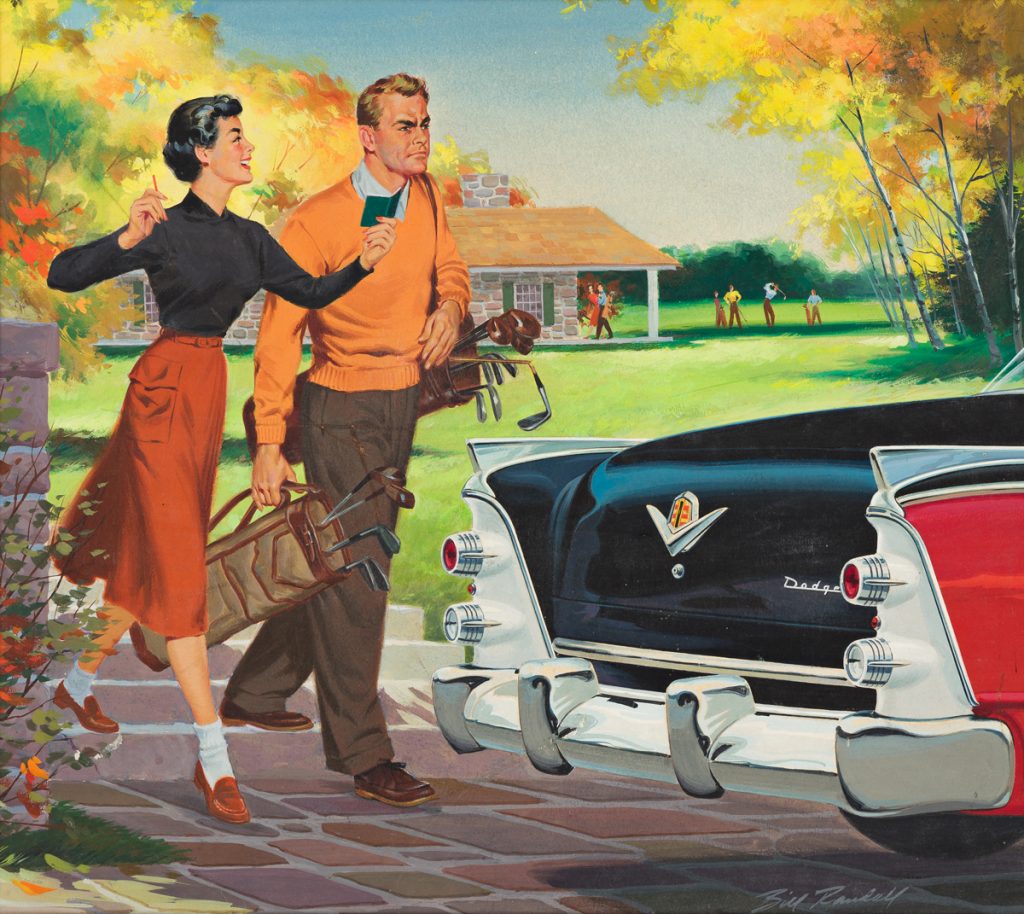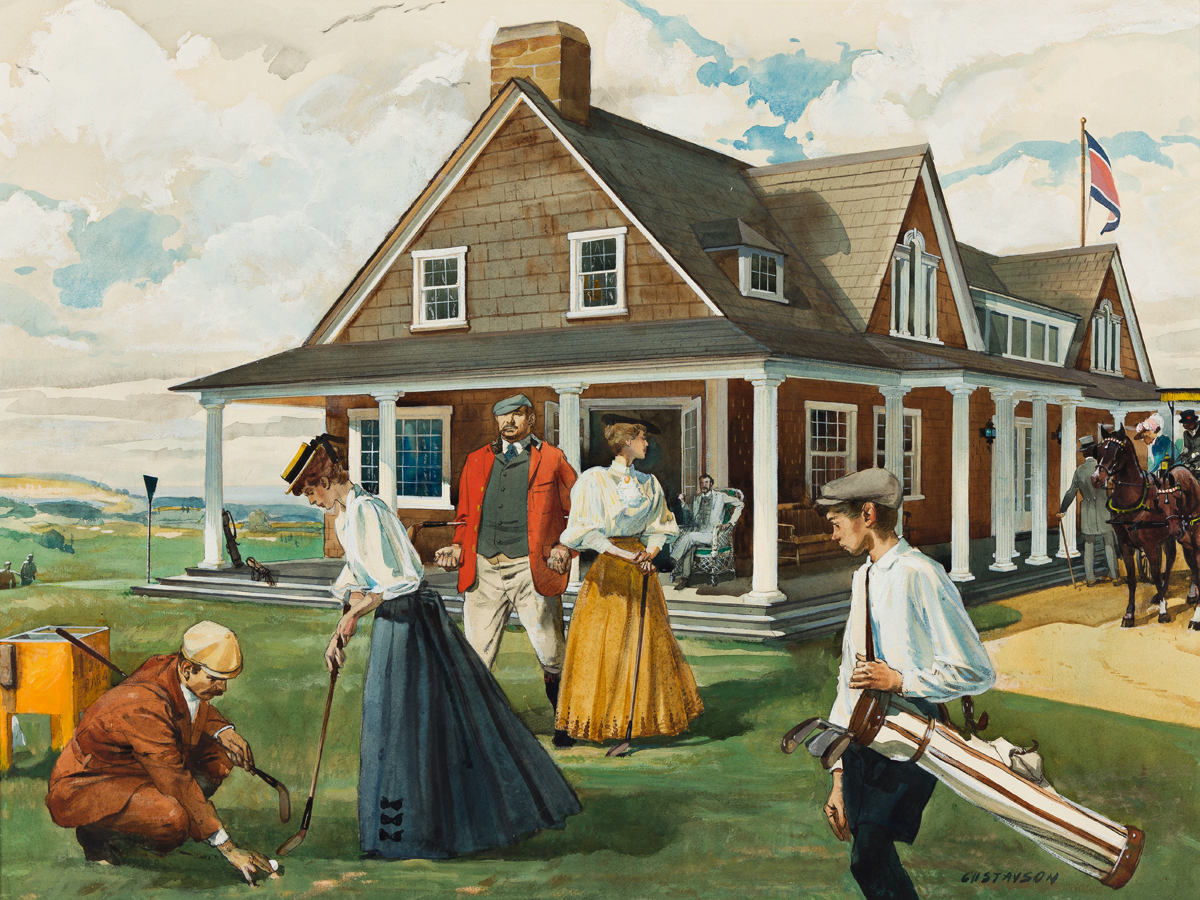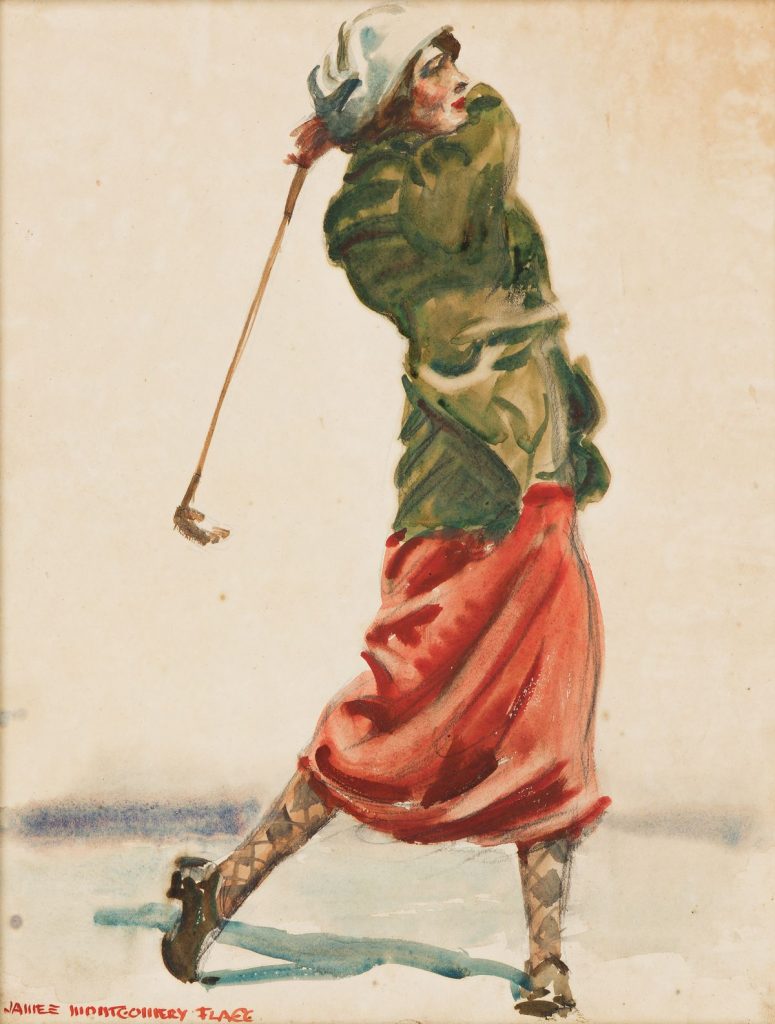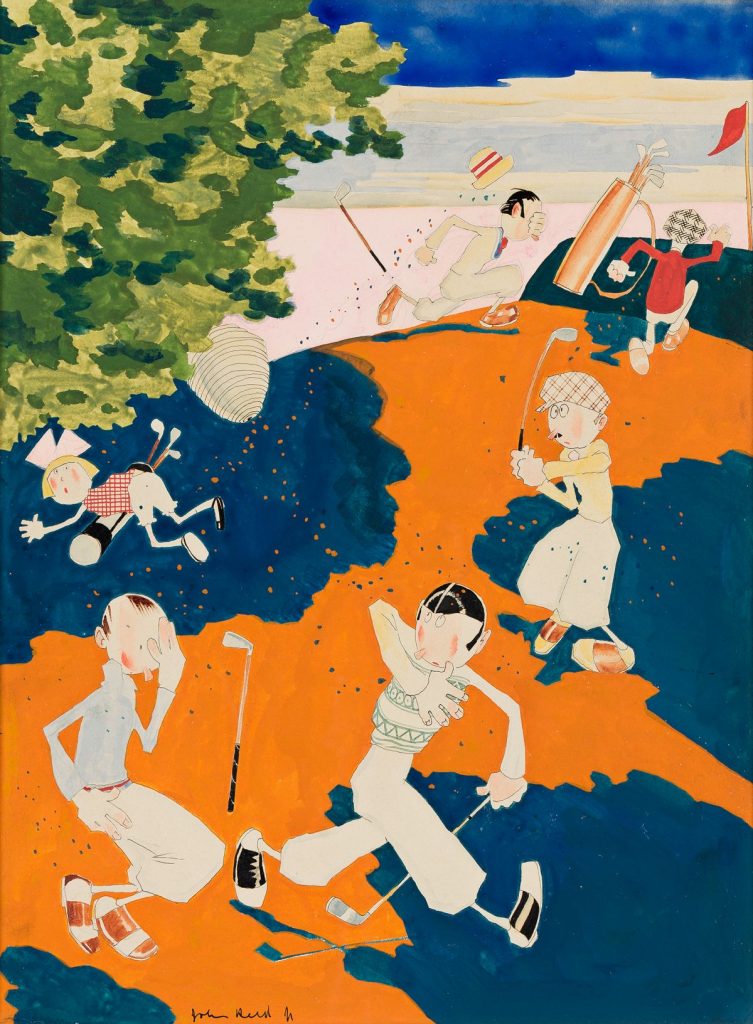An Interview with Dick McDonough — Collector & Connoisseur of Golf Illustrations

Swann’s January 28, 2021 auction of Illustration Art features 63 works of art (Lots 217 to 280) that are golf-themed, including original illustrations and rare printed posters and graphics from the collection of Richard “Dick” McDonough. Christine von der Linn, our director of illustration art, sat down with Dick, a retired attorney and author of the 2013 book Great Golf Collections of the World, to chat about what started him down the road from golf enthusiast to collector.
When did you discover the sport of golf and what drew you to it? Do you come from a family of golfers?
My first exposure to golf was as a caddy when I was 14 years old. It was an opportunity to learn about the game and, more importantly, about the golfers and the joy and frustration they experienced. My parents were avid golfers who enjoyed playing but did not excel. Their love of the game was adopted by their children, me included. One of my fondest memories is the numerous golf tournaments and outings that I played with my Dad.

Did you enjoy viewing art, picture books, or comics & cartoons as a boy? Did you often visit museums?
One of my favorite books as a youngster was an illustrated book about the great explorers who ventured to open new territories throughout the world. In my youth, the Tarzan books were popular, and I collected them. I also collected comic books like most of my contemporaries. My travels to art museums occurred later in life and was especially active when my career took me to Europe.
When did the golf “collecting bug” bite you? How did you settle upon visual representation of the game as opposed to its ephemera, such as clubs, balls, bags, tees, etc.?
In my youth I collected stamps and coins, especially Indian Head pennies, mainly because as a boy I could not afford more expensive and rare coins.
My hobby of collecting golf memorabilia occurred much later in life, in my 40’s. It was triggered by the discovery of a bag of wooden, hickory shafted, clubs in an antique store. The markings on the clubheads, called cleek marks, intrigued me. Most of the clubs in the bag were from Scotland, which piqued my interest. At the time there were no authoritative reference books that could identify the origins of the clubs. I ventured to the stacks of the Library of Congress to learn about them. My education and club collecting were off to a strong start.
Like most enthusiastic novice collectors, my lack of knowledge and focus, but an overexuberant sense of enthusiasm, lead to my failure to be discriminating in my acquisitions. I way over-collected. Even worse, in those early days and even in later years of my collecting, I branched out into other areas of golf memorabilia. At some point, I realized that although the clubs and other memorabilia captured both craftsmanship and history, golf art offered greater enjoyment and lent itself to various insights and interpretations. Simply put, I found art to be a much more interesting way to explore the meaning, depth, and dimensions captured in golf scenes rather than holding, examining, or admiring a rare golf club.
Illustration Art: Winter 2021 Highlights

People enjoy illustration for many reasons—the history, the stories, the nostalgia factor, or just the pictures. What do you personally like about this artwork?
Early golf art captures the dress, social setting, motion, spirit, and an accurate portrayal of times past. The scenes reveal a time capsule the realities of yesteryear. One art collector told me his paintings were the only accurate record that depicted unique design features of golf courses decades ago. Frequently early golf art is an important source of understanding how the game of golf developed.
Illustrations of attractive lady golfers were quite popular and, in some cases, had a major influence on the development of the game. For instance, Charles Dana Gibson portrayed his iconic creation, The Gibson Girl, in casual attire rather than the stiff Victorian dress that was common. As a result, women were freed from the heavy and cumbersome dress that was both very uncomfortable and severely restricted their swing. Ladies’ golf exploded in numbers.

As the famous ABC Wide World of Sports intro reminded us, players face ”the thrill of victory and the agony of defeat.” To that end, I have a two-part question: First, as you found these images, how many reflected the joy of golf and how many depicted the anguish?
Most illustrators reflected the joy of golf in their work. That was especially true for magazine covers since they needed to appeal to buyers who were much more likely to purchase an uplifting scene.
Perhaps A.B. Frost and John Held, Jr. were best at capturing the frustration of the game of golf. Frost sketched dozens of scenes depicting golfers experiencing extreme frustration, often in such a manner as to make them familiar and sympathetic, even humorous.

And second, regarding your own “agony of defeat:” any stories of ones that got away, amazing scores, mishaps, or other adventures of acquisition?
Perhaps my most memorable acquisition was of the A.B. Frost, Can This Be the Same Man? At the auction [where I originally bought it], it was noted that it was in the manner of Frost but not signed. Having written an article about Frost, I was totally familiar with his likeness, apparently, others were not. Frost had a unique way of signing this series of cartoons, he placed his image in five of the six cartoons. The piece was knocked down at an amount considerably lower than the going price for similar pieces.

Have you ever purchased a piece that you didn’t really like but found that it filled a gap, and did you sell and replace it when you found a more aesthetically pleasing “upgrade”?
No, but on numerous occasions, I purchased art, mostly online that was either not original or not illustrated by the artist as represented. This is particularly true of work by Charles Dana Gibson since, given his popularity, so many students and others copied his work.
Have you ever had the opportunity to exhibit your collection anywhere?
No, just subsets of my collection. However, a few years ago I gave a one-hour presentation to the Golf Collectors Society about the leading illustrators of golf art which included a snapshot of their biographies and notable golf illustrations, including several examples from my collection.
At the beginning, did you ever consider how large your collection might grow? Did you (and your wife) think about where it would all fit?
No. And yes, we ran out of wall space.

Lucky for us, Dick! You stated that your intention was to find an example from every major illustrator. Who proved to be the most elusive?
Of course, Norman Rockwell was the most difficult and far and away the most expensive. He illustrated fewer than ten golf scenes which are quite rare. I was never able to acquire one. Thirty years ago, a simple pen and ink ad sketch by Rockwell was priced at over $30,000. A full-color Rockwell canvas of a golf scene or golf-related would likely fetch seven figures. Likewise, golf art by J. C. Leyendecker commands premium prices. Although he illustrated a considerable number of golf scenes, they too are rare and not often found on the market.
How do you think golf memorabilia compares to collectibles for other sports? Are golf collectors, in your opinion, more passionate or crazier than collectors of other games’ memorabilia?
Over time collecting interest in golf memorabilia has changed significantly. Whereas years ago, collectors sought out a variety of unique and rare old collectibles such as hickory clubs, balls, illustrations, advertising, trophies, etc. now the most popular collectibles relate to “modern-day” memorabilia from any of The Grand Slam events or The Ryder Cup as well as dominant golfers such as Tiger Woods. Virtually anything from his era that relates to Bobby Jones continues to be in high demand.
On a related note, do you think the fact that it is one of the oldest sports factors into that?
I do not believe that the general public is particularly interested in the history of golf and certainly today’s millennials generally don’t seem to have the same interest in history as was the case in prior generations. As a consequence of this, the antiques business as well as numerous types of collectibles are experiencing a shrinking demand.

What did you learn about yourself while collecting? Did you discover you loved researching, the hunt, meeting people, traveling, etc.? And did collecting bring you a greater appreciation for the game and its history?
First and foremost, I enjoyed discovering a rare piece at a bargain price. The acquisition and taking those items into possession, i.e. adding them to the collection, produced a high. That feeling of discovery and first possession brought more enjoyment than routinely viewing an item in my collection.
As I delved into some of the outlying areas, such as Delft Tiles and 17th-century Dutch kolf art (a form of golf that was played on both land and ice), I needed to do extensive research to better understand the field. That led to writing articles about some of the more esoteric collectibles.
And yes, it absolutely gave me a greater appreciation for both the game and its history.
What are your favorite pieces in the collection?
Among the ephemera, which I still have, one of my favorite pieces is a rustic spliced head driver made by James Beveridge with the Shinnecock G.C. mark. It was one of my first acquisitions. It bears his stamp and that of Shinnecock where he was an early clubmaker and likely is pre-1900.
I enjoy my paintings of early seventeenth-century Dutch art of kolf, which I also have not parted with. Some historians contend that kolf was the predecessor to golf. Of course, the Scots take violent exception and make a convincing case that Scotland is the birthplace of golf.

Of the works in this auction, I would say the J.C. Leyendecker painting of the golfer lighting a cigarette is a favorite.
That is one of our favorites, too! The early twentieth-century artist was a master of poster, book, and advertising illustrations, most famous for his ads featuring the dashing “Arrow Collar Man” and for numerous covers for The Saturday Evening Post.
You also have a number of non-golf illustrations in this sale including some wonderful baseball, football, and tennis images. Do you have a favorite among those?

I love J.F. Kernan’s Saturday Evening Post cover, College Football. His choice of vibrant colors in an action-packed scene captures an exciting still-life image of athletic prowess. We find ourselves in the action and are able to share the thrill of the moment. The resolve and determination of the player clutching the football are etched on his face in contrast to the frustration of his pursuers. One might never tire of studying this painting and exploring its meanings and dimensions. The strong resemblance to the Heisman Trophy issued two years later gives it a unique place in the history of football imagery.

Do you have a collection of original illustrations we should take a look at?
Learn about how to consign to an auction, and send us a note about your item.













![Grace Meschery-McCormack shares about two copies of Fernando de Rojas’s ‘La Célestine,’ including a limited edition copy illustrated by Pablo Picasso.
At auction April 22. Learn more about the works at the link in our bio.
#Rarebooks #rarebookdealer #antiquarianbooks #auctions
_______________________________________
Music Credit:
Schubert - Piano Quintet in A major ‘The Trout’, D. 667 - IV. Andantino – Allegretto
Music provided by Classical Music Copyright Free on Youtube [https://tinyurl.com/visit-cmcf]
Watch: • Schubert - Piano Quintet in A major ‘...]](https://scontent-iad3-1.cdninstagram.com/v/t51.75761-15/491443494_18499096345036585_5935932878956098058_n.jpg?stp=dst-jpg_e35_tt6&_nc_cat=107&ccb=7-5&_nc_sid=18de74&_nc_ohc=OlBShB8qEWAQ7kNvwHbrXqd&_nc_oc=Adn09Fh3YL-11OkpQcrYGgFN9beLpm0IfGUn2bwN7iJs6d4v8qMeP8kSYmCw82y2ewU&_nc_zt=23&_nc_ht=scontent-iad3-1.cdninstagram.com&edm=AM6HXa8EAAAA&_nc_gid=ALjW-WotoJKMhmSxb3MjdA&oh=00_AfHxnW1r6azPkfEpGu23ZkOrQJZhFUze5da2x2sbKDWsbw&oe=681AE6D1)




